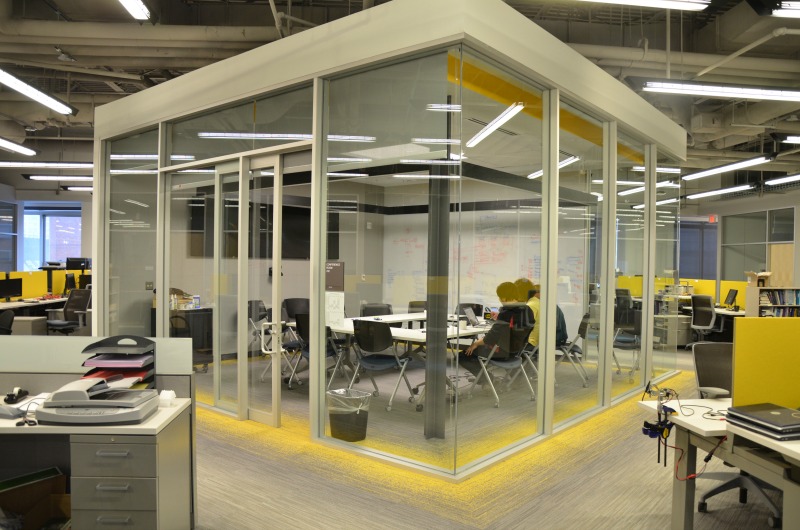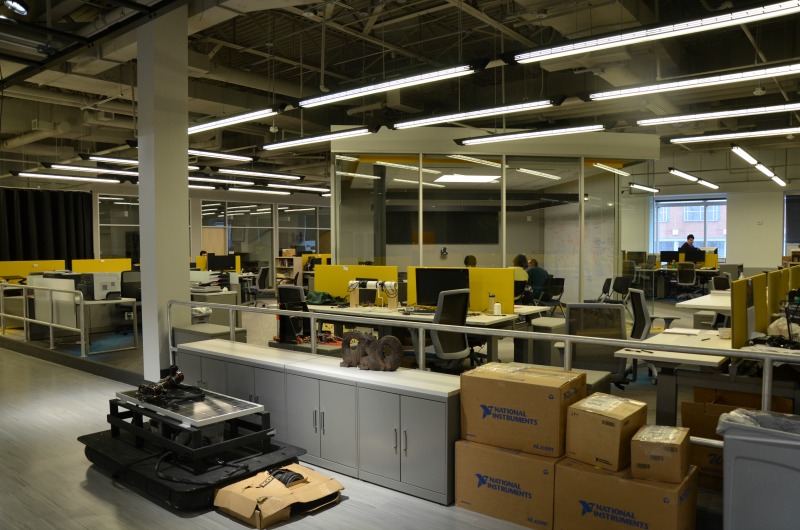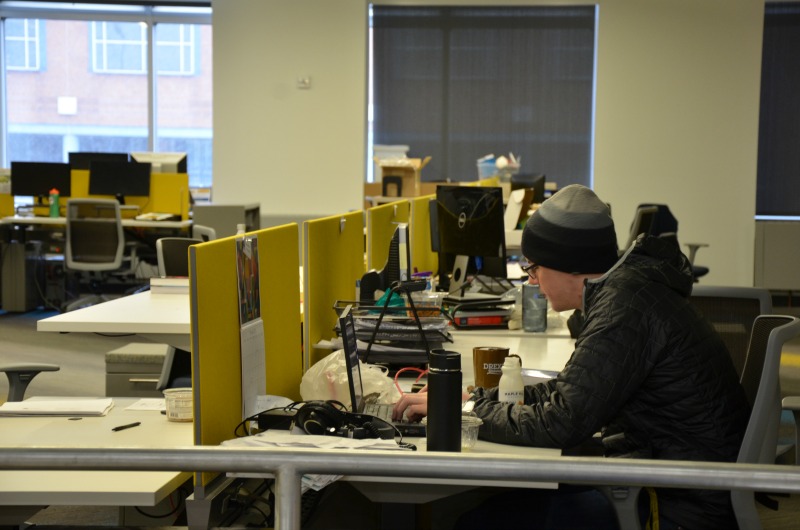 Collaboration is nothing new for the College of Engineering’s Kapil Dandekar, PhD; Adam Fontecchio, PhD; and Timothy Kurzweg, PhD. The professors have been working together on projects for years and even hold some joint patents together. What is new, however, is where they work: a unique, customized shared lab and office space at 3101 Market St. that’s much more conducive to research than the individual labs they used to have.
Collaboration is nothing new for the College of Engineering’s Kapil Dandekar, PhD; Adam Fontecchio, PhD; and Timothy Kurzweg, PhD. The professors have been working together on projects for years and even hold some joint patents together. What is new, however, is where they work: a unique, customized shared lab and office space at 3101 Market St. that’s much more conducive to research than the individual labs they used to have.
The professors share the space with Youngmoo Kim, PhD, an associate professor in the College of Engineering and director of the Expressive and Creative Interactive Technologies (ExCITe) Center, and Pramod Abichandani, PhD, an assistant clinical professor in the LeBow College of Business. For the past 10 years, they’ve worked together by going back and forth between labs located on different floors in the Bossone Research Center — Fontecchio and Kurzweg were on the fifth floor, Kim was on the fourth floor and Dandekar and Abichandani were on the third floor. Now, the five professors have combined four labs in their new home: Dandekar’s Drexel Wireless Systems Laboratory, Kurzweg’s Drexel Opto-Electo-Mechanical Laboratory (affiliated with Dandekar and Fontecchio), Fontecchio’s Drexel Nanophotonics+ Lab and Kim’s Music and Entertainment Technology Laboratory (MET-lab). It’s never been easier for them to work on their own projects and collaborations to better create and understand radios, antennas, functional fabrics, electronic smart systems and robots, for example.
“We’re trying to make this space as collaborative as we can with people from different labs spread out and intermingled with one another” said Dandekar, who is a professor of electrical and computer engineering and associate dean for research and graduate studies.
 The opportunity to move into a joint space came about because of the University’s plan to renovate some of its core research laboratories. Initiated in 2014, Drexel’s Research Laboratory Plan will use approximately $49 million worth of investment to create and update labs in the Bossone Research Enterprise Center, the Center for Automation Technology, the LeBow Engineering Center and — as these professors can personally vouch for — 3101 Market St.
The opportunity to move into a joint space came about because of the University’s plan to renovate some of its core research laboratories. Initiated in 2014, Drexel’s Research Laboratory Plan will use approximately $49 million worth of investment to create and update labs in the Bossone Research Enterprise Center, the Center for Automation Technology, the LeBow Engineering Center and — as these professors can personally vouch for — 3101 Market St.
They’ve been involved with the design of the lab since the very beginning, having met with architects as well as Drexel undergraduate architectural engineering students to figure out what the space would look like.
“This was a very fun opportunity to think a little bit outside the box to determine how we can best work together and how the space could help,” said Fontecchio, professor of electrical and computer engineering, vice dean of the Graduate College and director of the Center for the Advancement of Stem Teaching and Learning Excellence (CASTLE).
The resulting lab space, located on the second floor of One Drexel Plaza in 3101 Market St., is “a dream three years in the making,” said Fontecchio.
It’s an understatement to say that the space is bright and inviting. The walls are bright yellow, with correlating furniture and rugs, and the lab’s front doors and walls are made of glass to better encourage students to stop by and see what’s happening, whether it’s from the nearby freshman design labs, machine shops or the Institute for the Energy and the Environment. Another incentive for students: a lounge area outside the space featuring wooden walls that double as white boards (students can write on them while working together) and nearby tables and work stations with pop-up power capabilities, USB ports and screens to practice presentations on.
Inside the lab, the collaboration opportunities are even greater.
“We designed the space hoping that students would end up talking and even working with other students they wouldn’t normally see,” said Kurzweg, an associate professor in the Department of Electrical and Computer Engineering. “There’s just so much synergy between our different areas of expertise and research that it makes sense for students to communicate with each other and develop their own projects together.”
 Those students now sit in open workstations, a complete turnaround from the isolating, private cubicles in the old labs. A glass-walled conference room is stationed in the middle of the room, while the professor’s offices (also with glass facades) line the perimeter of the open space. There’s also a communal work area, called “the dragon’s den,” that is a wide, open space tall enough to fly drones and wide enough to have robots zoom around.
Those students now sit in open workstations, a complete turnaround from the isolating, private cubicles in the old labs. A glass-walled conference room is stationed in the middle of the room, while the professor’s offices (also with glass facades) line the perimeter of the open space. There’s also a communal work area, called “the dragon’s den,” that is a wide, open space tall enough to fly drones and wide enough to have robots zoom around.
The professors also designed lab rooms to fill needs that had long been lacking. A dual-reverberation chamber was built to simulate different types of wireless environments to test electromagnetic capability testing and test radios. Before, they would have to travel to a naval base in Virginia to work with such an unusual chamber. Another lab offers deionized water on tap, which the professors and students previously had to obtain at a chemistry department across campus, one gallon at a time.
Outside companies could come in to use the labs and even set up a home in the space — like Fontecchio’s company, Dragon Spectrum — to bolster Drexel’s contributions to the Innovation Neighborhood.
It’s just one of the many, many ways that the space was designed to put Drexel’s best research efforts forward.
“It’s pretty exciting to have full capability in this space,” said Fontecchio, “and it’s definitely an improvement to finally all be in one place.”